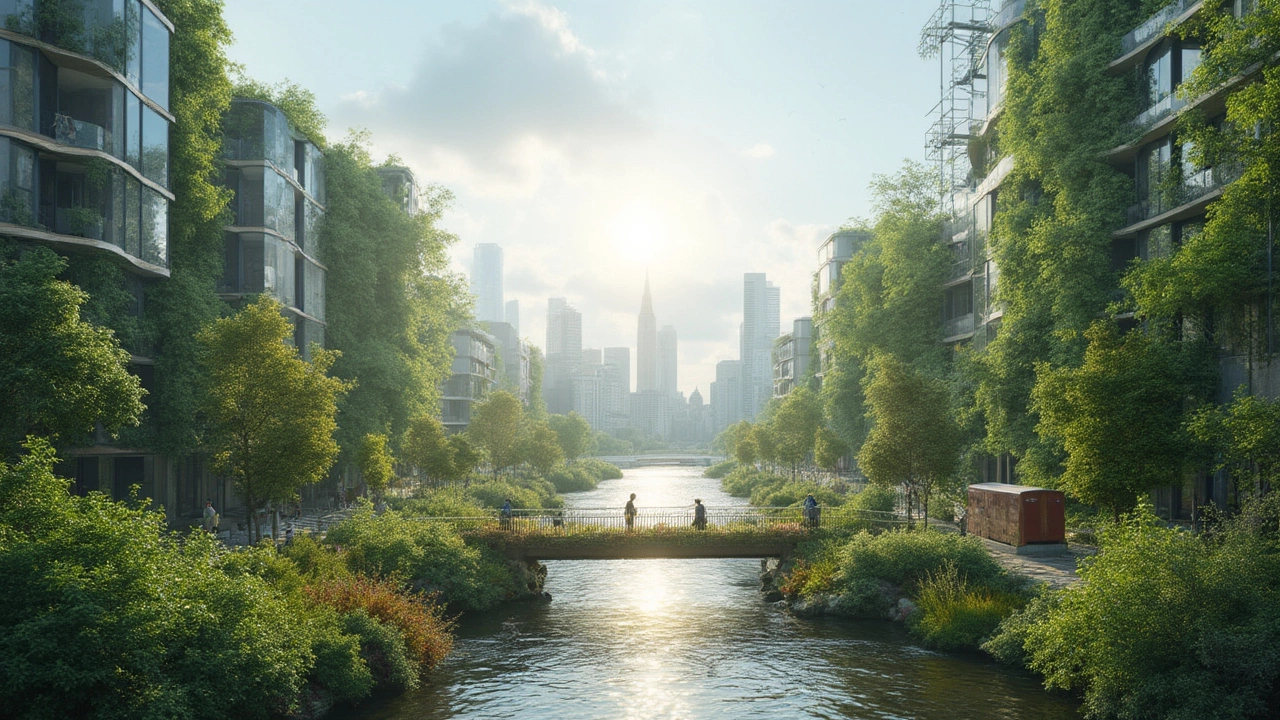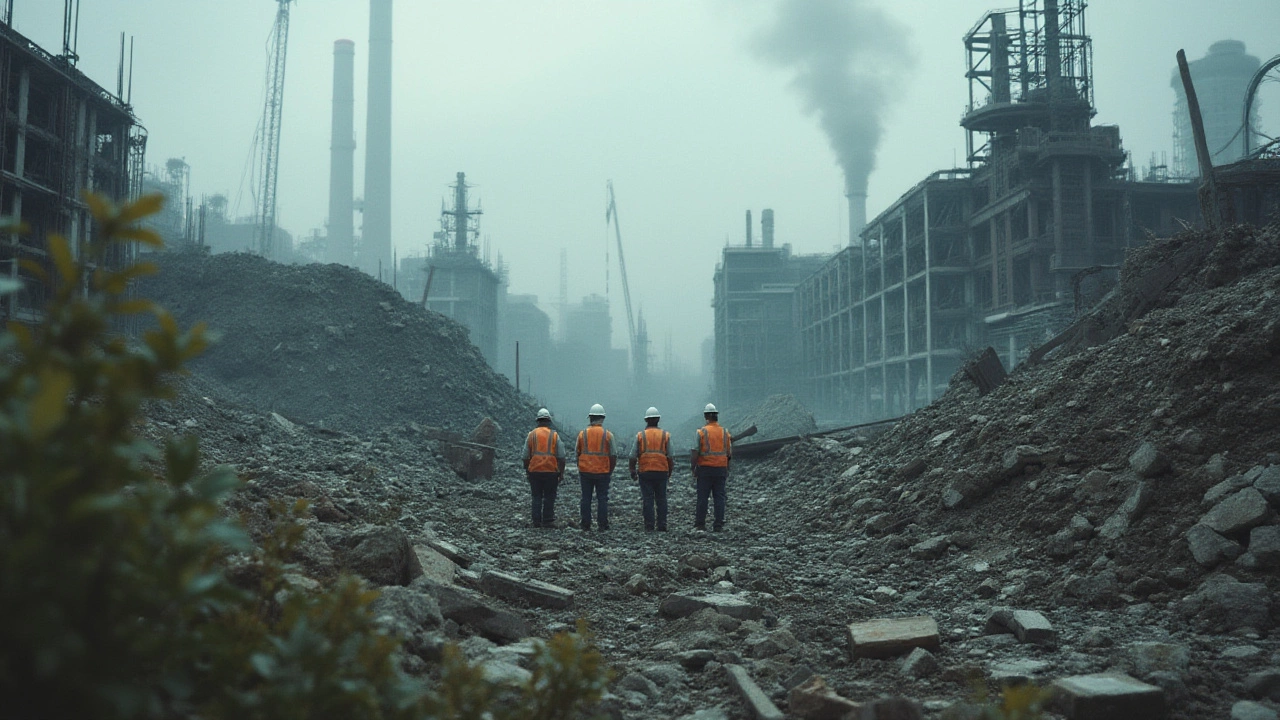Imagine you’re standing on a plot of land, ready to build your dream home or office. You might picture sturdy bricks, shiny concrete, and sparkling glass—all ready to become something beautiful. But here’s the catch: not everything that looks strong and reliable is actually good for our planet. Some building materials, as solid as they seem, have a nasty secret—they’re seriously harmful to the environment. And every new foundation using them sets us a step back from a healthier, greener world.
What Makes a Building Material Eco-Unfriendly?
The issue starts even before a wall goes up. Traditional building products like concrete, steel, and some plastics leave a heavy mark on the environment—starting with how they’re made. Picture the factories powering day and night, spewing out carbon dioxide and using up crazy amounts of water and raw resources. It isn’t just the making of these materials, either—it’s also how they’re moved across countries, how much waste they create, and what happens when a building gets demolished. All these stages add up to a story that’s much less about comfort and much more about cost to the planet.
For example, manufacturing cement, the glue in concrete, is responsible for about 8% of all global carbon dioxide emissions. That’s more than all the world’s trucks combined, just from making one material! And steel? While it’s just as common, it uses even more energy and releases loads of greenhouse gases. Then there’s plastic-based insulation and PVC (polyvinyl chloride), those hidden layers in walls and plumbing. Their origins are fossil fuels, and their production means toxic chemicals can seep into soil and water—things you definitely don’t want near your backyard garden.
Even transportation counts. Take granite countertops: often mined in far-off places like Brazil or India, then shipped halfway around the world. Those smooth, shiny slabs might look amazing in your kitchen, but the carbon footprint behind them is enormous. Plus, if a product can’t be recycled or breaks down into harmful bits, it just hangs around in landfills, leaking dangerous stuff for years.
So when experts talk about eco-unfriendly building materials, they mean anything with a high ‘embodied energy’ (total energy used from mining to disposal), releases large amounts of carbon, pollutes water or air, or is likely to end up as non-biodegradable trash. It’s not about hating every familiar tool—it’s about asking what invisible price comes with every shiny new surface.
| Material | Embodied Energy (MJ/kg) | Major Environmental Issues |
|---|---|---|
| Concrete | 1.2 | High CO2 emissions |
| Steel | 20-35 | Excessive energy use, carbon footprint |
| PVC Plastic | 80-100 | Toxic production, non-biodegradable |
| Aluminum | 170-200 | Energy-intensive, mining damage |
| Brick | 2.5-5 | Resource depletion, air pollution |
One thing that often goes unnoticed is water usage. Some materials need a lot of water during manufacturing. For instance, clay bricks and concrete guzzle water at every stage. In regions already struggling with droughts, this can be a massive concern.

Specific Building Materials to Look Out For
Let’s talk names. When it comes to the biggest culprits, a few classic construction materials stand out for being anything but eco-friendly building materials. At the top of the list is concrete. It’s everywhere—from sidewalks to skyscrapers. The trouble is, its key ingredient, Portland cement, is made by heating limestone with clay at temperatures above 2500°F. This uses up huge amounts of fossil fuel. For every ton of cement produced, nearly a ton of carbon dioxide is released into the atmosphere. Multiply that by the billions of tons made each year, and you have what climate scientists call a ‘carbon bomb.’
Steel isn’t much better. Sure, it’s strong and endlessly recyclable, but creating new steel still requires blasting iron ore with coal in enormous furnaces, leading to pollution and mountains of slag waste. Even with recycling, a big chunk of the global supply still comes straight from raw mining. Aluminum has a similar story, with sky-high energy needs and serious mining impacts, especially in tropical regions where rainforests are cleared to get at bauxite ore.
Then there’s insulation—stuff that keeps your home warm or cool. Some forms, like fiberglass and traditional spray foam, are full of synthetic chemicals, glass fibers, or petroleum byproducts. When cut or installed, they can release tiny particles that are hazardous for both installers and the planet. And if you think wood is always a winner, think again. Not all wood is created equal. Old-growth hardwoods harvested from vulnerable rainforests take centuries to regrow. Using them for quick-and-cheap furniture kicks off massive biodiversity loss and soil erosion. Even engineered wood, like MDF and some plywood, often relies on glues containing formaldehyde, a chemical linked to respiratory problems.
PVC, which is everywhere from pipes to window frames, carries a whole list of concerns—its production can release dioxins, among the most toxic manmade chemicals known. These substances persist in soil and water, accumulating up the food chain. Add to that vinyl flooring, cheap and trendy, but made with harmful phthalates. When these floors age, they can release these chemicals as dust. Not exactly the “clean and healthy” vibe we expect at home. Other plastics—think polystyrene insulation or acrylic sheets—come with their own baggage: non-renewable fossil fuel origins, pollution during production, and microplastic pollution when they eventually wear down.
Even some ceramic tiles raise issues. Fancy imported tiles might use toxic glazes and travel thousands of miles, burning fuel the whole way. Asbestos can still be found in some older building materials and, while banned in many countries, it’s a reminder that building products can outlast health knowledge for decades. And let’s not forget bitumen-based roofing—a material made from crude oil that eventually turns brittle, cracks, and leaches chemicals into rainwater runoff.
If you’re looking at modern architecture, pay attention to glass. Those dazzling glass facades? They seem sleek, but sheet glass needs a ton of energy to create and often ends up as difficult-to-recycle waste due to coatings or laminates. And with double or triple glazing, those impacts multiply fast.
If you’re feeling like “everything’s bad,” don’t! There’s a big movement to challenge these habits. Green certifications for buildings now set strict caps on ‘embodied carbon,’ and architects are experimenting with hempcrete, recycled glass, rammed earth, bamboo, and even mushroom-based insulation. But it’s important not to get sucked in by greenwashing. Some products might market themselves as “eco,” but still contain unsustainable elements or create problems down the line. Always dig a little deeper—ask for certifications, check country-of-origin, and see if a material can be re-used or safely return to nature.

Tips for Building with a Clear Conscience—and What to Choose Instead
So, what can you do if you want to skip the guilt and build with the planet in mind? First, don’t be in a rush to tear out and replace what already exists. Extending the life of current buildings by upgrading windows, repairing leaks, and improving energy performance can be greener than starting from scratch. If you have to build new, go for materials that can be recycled, composted, or reused. And check if there’s a discounted “salvaged” option for bricks, beams, or fixtures—you’ll save money and emissions, too.
Bamboo is a superstar when grown and harvested right—it’s technically a grass, regrows quickly, and tough as nails. Pressed straw or hemp panels can be excellent for walls and insulation. Sheep’s wool, recycled denim, and cellulose made from old newspapers are cozy, safe, and biodegradable. If you do use timber, choose local sources with FSC (Forest Stewardship Council) certification, which means forests were managed responsibly. Mud and rammed earth sound old-fashioned, but new building techniques make them reliable, beautiful, and nearly carbon-neutral.
Switching from traditional concrete to geopolymer concrete or adding fly ash from power plants lowers emissions by reusing industry leftovers. Stone and brick, if sourced nearby, age beautifully and last centuries without constant repairs. Even using green roofs (layers of plants on rooftops) helps filter air, trap rainwater, and keep cities cooler.
Another tip: watch out for ‘end-of-life’ scenarios. Can your chosen material be recycled easily? Will it leach toxins if thrown in a landfill? If something must be synthetic, look for recycled plastics—these have about half the carbon footprint of new plastics, and keep waste bottles out of dumps.
And don’t get fooled by simply swapping one material for another. For example, aluminum windows marketed as “green” might use recycled metal but could still come with huge energy bills from manufacturing. Sometimes, old-school wood or thermally broken steel offers similar energy efficiency without such a heavy carbon load.
Lastly, ask suppliers for Environmental Product Declarations (EPDs) and Life Cycle Analyses (LCAs). These documents spell out impacts clearly—energy, emissions, water use, and toxic byproducts—so you can make smart comparisons. If you want extra credit, try using construction calculators available online to see how your choices measure up before you buy. It’s amazing what happens when you put a little pressure on your architects and builders—they’ll be forced to source better stuff, and the demand can shift the entire market toward greener options.
So, next time you walk past a building site or plan your own project, don’t just focus on appearance or price. Remember, every brick, beam, and panel tells a story about our planet’s future. Ask questions, seek better options, and know that a bit of effort today can help pave the way—quite literally—to a cleaner, safer tomorrow.
